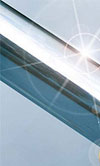Polishing & finishing
 When we specify or design components for a racing engine, quite often we are interested in the surface finish. It is an important aspect of the overall perceived quality of the component, and it can have a large influence on the performance of the part in question for a number of reasons, of which there are three main ones to consider, namely endurance, wear and friction.
When we specify or design components for a racing engine, quite often we are interested in the surface finish. It is an important aspect of the overall perceived quality of the component, and it can have a large influence on the performance of the part in question for a number of reasons, of which there are three main ones to consider, namely endurance, wear and friction.
In terms of endurance, we know from reading Race Engine Technology, other magazines, learned papers and textbooks but probably more from experience, that poor attention to surface finish can cause a part to break. The textbooks will help us quantify the effect of surface finish on the fatigue strength of materials by giving us de-rating factors which depend on the process by which the surface is prepared and the level of finish that it achieved. We know that a part with a machined finish should be more durable than one which has a cast finish, that a ground finish should be more durable still, and that a component with a polished surface should prove to have the greatest fatigue resistance of all of these surfaces. A polished bar, such as that shown in the accompanying picture, will have a higher fatigue limit than a machined bar of the same material and dimensions. There are, of course, various levels of ground finish, or machined finish, and often the subtleties of the method of finishing are important, such as the alignment of any machining marks compared to the load path in the part. So, in this case, surface finish has a delaying effect in the initiation of surface cracks.
It is not difficult to imagine or demonstrate the effect of surface finish on wear. One only has to imagine the difference between rubbing one's hand against a smooth piece of metal and a cheese-grater or a file to see that surface finish on a smaller scale can cause wear. This wear mechanism is abrasive wear and the ploughing effect of hard asperities (peaks in the small-scale surface finish of the part) is the main mechanism by which material removal is effected. By providing a smooth surface finish we can reduce wear by limiting the ploughing action of asperities, and by finding it easier to establish a protective lubricant film. Wear not only leads to harmful wear particles being carried to parts of the engine which are vulnerable to damage from such debris, but to loss of precision and early failure. Also, if wear debris remains within the contact area it can cause further damage.
In terms of friction, improvements in the surface finish can lead to lower frictional losses and therefore improved engine performance. This is especially true where lubrication is concerned. When the 'combined' surface finish of the two surfaces in contact is less than the established film thickness of the lubricant, then the coefficient of friction in the contact is determined solely by the action of oil shear. When there is no lubricant present, we have the coefficient of dynamic friction acting and at any point in between these two points we have boundary, or mixed lubrication, where the coefficient of friction is some intermediate value. By having a smooth surface, we need establish only a thin oil film in order to minimise friction and prevent damage.
In the next article we shall begin to consider some processes by which we can achieve a really good surface finish and look at some of the possible applications.
Fig. 1 - Polished bar.
Written by Wayne Ward